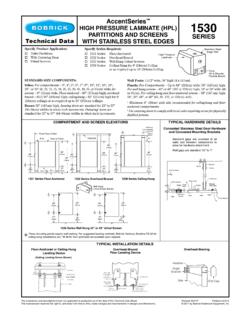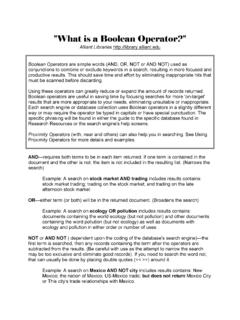Transcription of TECHNICAL NOTES 4 VIBRATING SCREENS - Mineral Tech
1 Copyright R P King 2000 TECHNICAL NOTES 4 VIBRATING SCREENS4-1 SIZE CLASSIFICATIONIt is always necessary to control the size characteristics of particulate material that is fed to processequipment that separates the mineralogical components. It is not possible within the productionenvironment to exercise precise control over the size of all particles in a population and, in mostcases, size classification equipment is designed to split a feed of particulate material into a coarseand a fine product. Occasionally one or two product streams of intermediate size may be producedsuch as by a double or triple deck screen . Probably the most common application of sizeclassification is its use to prevent oversize material leaving a comminution circuit. Oversize materialis recycled to a comminution stage for further size reduction before passing to subsequent stages most significant consideration when evaluating classification equipment is the lack of a cleancut at a particular size.
2 Even the most efficient industrial size classifiers will pass a proportion ofoversize material and will retain a portion of undersize classification equipment is also subject to capacity limitations and these must be consideredwhen evaluating the performance of new or existing classification equipment. In fact older methodsof performance evaluation concentrate entirely on the capacity limitations. However, more modernprocedures recognize that the efficiency of separation must also be considered if the performanceof a size classifier in a plant circuit is to be accurately evaluated. The procedures that follow take thisinto account. There are essentially two types of classifier available for process operation: SCREENS and classifiersthat rely on the variation of terminal settling velocities of particles of varying size when these areimmersed in a viscous fluid. In general the former are used for the classification of drier materialat coarser sizes.
3 Based on Sieving - VIBRATING screensThe basic method of operation of a screen is very simple. The screen presents a barrier to thepassage of oversize material while it readily passes undersize material. It is only necessary to ensurethat each particle has an opportunity to reach the screen . In practice each particle is given severalopportunities to pass through the screen . SCREENS can be stationary or the screen can vibrate whichincreases the rate of presentation of each particle and assists in moving oversize material over andaway from the screening surface. Models based on screen capacityThe traditional method of evaluation of screen performance is the use of a capacity measure. Thisrepresents the ability of the screen to accept and handle the feed tonnage of material. The mostimportant assumption in this approach is that the capacity of a screen is directly proportional to its4-2surface area so that the basic capacity is specified at tons of feed per hour per square meter of quantity is represented by Iu.
4 The basic capacity of any screen is determined under standardoperating conditions using a predefined standard feed material. As the nature of the feed materialchanges and as the operating conditions change so the actual capacity of the screen changes - it willincrease for conditions less arduous than the standard and decrease for conditions more arduous thanthe standard. These modifications are represented by capacity factors which multiply the standardunit screen capacity to get the actual screen capacity under conditions that the screen will actuallymeet in its position in the operating plantRated screen feed capacity IuK1K2 Iu iKitons/hr m2(4-1)where the separate Ki are the capacity factors for deviations from the standard conditions with respectto a number of individual basic unit capacity varies primarily with the size of the screen opening - SCREENS with largeropenings being able to handle large quantities of feed material.
5 A typical relationship between Iu andmesh size isIu 37forh 25 mm(4-2) <25 mm(4-3)where Iu is in tons/hr m2 and h is the mesh size in mms. Each screen manufacturer has its own basiccapacity-size relationships for its range of SCREENS . The above expressions are only meant to definea typical individual capacity factors are provided by screen manufacturers in tabular or graphical formalthough the availability of computers is encouraging the presentation of these factors in algebraicform. The following factors are typical for woven wire mesh open area factor K1 The standard condition is usually 50% open area and the capacity is proportional to the open % open area50(4-4)For material having a bulk density less than 800 kg/m3 the standard open area is 60% rather than50% and equation ( ) should be modified half-size factor K2 Feed that contains a large proportion of material that is considerably smaller than the screen meshsize will be handled more easily by a screen .
6 The standard condition is defined as feed materialhaving 40% smaller than one half of the mesh size. If the feed has more than 40% smaller than one4-3half of the screen mesh size, the half-size factor will exceed unity and vice 2PF( ) (4-5)The oversize factor K3A screen can handle a greater tonnage of feed material that contains large quantities of oversizematerial because this material passes directly over the screen and need not be transmitted throughthe mesh. This is accounted for by the oversize factor K3 which has a value of unity for a standardfeed containing 25% oversize material. This factor increases very quickly as the fraction of oversizeincreases and is given byK3 exp exp( PF(h) )(4-6)In equation ( ) is the fraction of material in the feed that has size greater than the screen PF(h)mesh size h. It is related to the cumulative size distribution function by PF(h) 1 PF(h)(4-8)The bulk density factor K4 Denser materials will be transmitted more easily than lighter materials.
7 A factor K4 accounts for thiseffect when bulk density differs from the standard of 1600 kg/m3K4 !B1600(4-9)The deck position factor K5 SCREENS that are lower down in the deck receive undersize from the screen above and can handle lessmaterial than a screen that takes fresh feed. The capacity decreases with position according tocapacity factor K5K5 (4-10)where S represents the deck position; 1 for top deck, 2 for 2nd deck and so screen angle factor K6 The standard inclined screen has an angle of inclination of 15o. Lower angles of inclination increasethe projected area of the screen aperture in the horizontal plane and the screen can handle a greaterload. This is accounted for by capacity factor K6K6 (. 15)(4-11)where . is the angle of inclination in wet screen factor K7 Screening at finer mesh sizes can be improved by spraying the screen load with water. The factorK7 accounts for this effect4-4K7 10 4(25 h) 25 mm >25mm(4-12)The aperture shape factor K8 The standard screen has square openings andother shapes influence the capacity as shown inthe shape factor K9 Slabby and elongated particles are more difficultto screen than particles that are essentiallyisometric.
8 If the feed contains about 15% ofslabby or elongated particles K9 should be set Larger amounts of this type of materialwould give significant problems and would needto be investigated surface moisture factor K10 Surface moisture tends to make the particlesadhere and screen capacity is reduced. FactorK10 accounts for this and can be evaluatedfrom the table screen transmission efficiencyIdeally the screen should be able to transmitall of the undersize material in the feed. Inpractice, however, not all of the undersizematerial passes through the screen and thefraction of the feed undersize that does passthrough is referred to as the screen efficiency is determined primarily by theactual feed loading on the screen relative tothe rated feed capacity as calculated byequation ( ). The efficiency of transmissiondecreases if the screen must handle feed in excess of 80% of the rated tonnage because the accessof individual particles to the screen surface is hindered to a greater or lesser degree.
9 The efficiencyalso decreases as the actual feed tonnage falls below 80% of rated capacity because particles tendto bounce on the lightly loaded screen and make fewer contacts with the screen WF represents the actual feed tonnage, then the rating ratio is given byCondition of feedK10 Wet, muddy or sticky surface quarried and materialfrom surface stockpiles with up to14% moisture by crushed or artificially Surface moisture capacity factor of screenopeningK8 RoundSquare2 to 1 rectangularslot3 to 1 rectangularslot4 to 1 screen capacity factor for differentapertures4-5RR WFIu iKi screen area(4-13)and the efficiency of transmission is given bye (RR ) (RR )2forRR ( RR)2forRR< (4-14)The actual tonnage passed to the undersize stream isWU ePF(h)WF(4-15)Each size class smaller than the mesh size is subject to the same efficiency factor e so that theparticle size distribution in the underflow stream is calculated in discrete form aspUi epFiWFePF(h)WF pFiPF(h)fordpi<h 0fordpi h(4-16)where piU is the fraction of the underflow stream in the size class i and piF that fraction in the actual tonnage passed to the overflow stream isWO (1 PF(h))WF (1 e)PF(h)WF WF(1 ePF(h))(4-17)and the discrete size distribution in the overflow stream is given bypOi (1 e)pFi(1 ePF(h))fordp<h(4-18) pFi1 ePF(h)fordp h(4-19)The simple capacity model permits the calculation of the total screen area that is required for aspecific duty.
10 The aspect ratio of the screen (length/width ratio) must be determined by consideringthe depth of the bed of particles on the screen . An approximate guide is the restriction of the beddepth at the discharge end to no more than 4 times the mesh size. The thickness of the bed isdetermined by the total flowrate over the screen surface, the width of the screen , b, and the velocityof travel of the material along the WObu!b(4-20)where tb is the bed thickness, Wd the mass flowrate across the discharge end, b the screen width, uthe velocity of travel across the screen surface and !b the bulk density. The velocity of travel dependsprimarily on the angle of inclination and the amplitude and mode of The Classification FunctionA more realistic description of the performance of a classification device is provided by theclassification function. This function defines the probability that an individual particle will enter theoversize stream that leaves the classifier.











